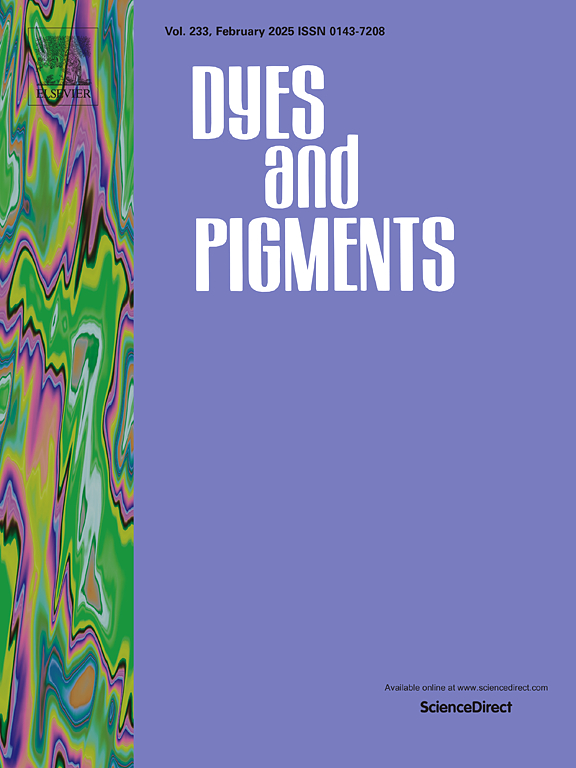Construction of phenanthro[9,10-d]oxazole-based “hot exciton” AIEgens via molecular isomer engineering for efficient blue non-doped OLEDs
IF 4.1
3区 工程技术
Q2 CHEMISTRY, APPLIED
引用次数: 0
Abstract
“Hot exciton” materials with aggregation-induced emission (AIE) properties have tremendous potential for application in high-performance blue non-doped organic light-emitting diodes (OLEDs). In this study, two novel blue fluorophores POT-1 and POT-2 were designed and synthesized by molecular isomer engineering. In two molecules, phenanthro [9,10-d]oxazole/triphenylamine acted as acceptor/donor, and triphenylethylene was used as the AIE-active moieties. Both fluorophores displayed excellent thermal properties and blue emissions with decent fluorescence efficiencies. Theoretical calculations proved that POT-1 and POT-2 possessed hybrid local and charge transfer (HLCT) properties with the “hot exciton” channels from T3/T4 to S1. Additionally, POT-1 and POT-2 also exhibited AIE and mechanochromism effects, especially POT-1 showed a large redshift of 62 nm after grinding. The blue non-doped OLEDs based on the two emitters were prepared and the POT-2-based device demonstrated better performances of 9.48 cd A−1, 8.27 lm W−1 and 4.77 %. These results indicate the feasibility of molecular design via positional isomerization engineering to develop blue AIEgens with HLCT characteristics.

基于分子异构体工程的菲[9,10-d]恶唑基“热激子”AIEgens在高效蓝色非掺杂oled中的构建
具有聚集诱导发光(AIE)特性的“热激子”材料在高性能蓝色非掺杂有机发光二极管(oled)中具有巨大的应用潜力。本研究采用分子异构体工程的方法,设计合成了两个新的蓝色荧光团POT-1和POT-2。在两个分子中,菲[9,10-d]恶唑/三苯胺作为受体/供体,三苯基乙烯作为aie活性基团。两种荧光团都显示出优异的热性能和蓝色发射,具有良好的荧光效率。理论计算证明了POT-1和POT-2具有从T3/T4到S1的“热激子”通道的混合局部和电荷转移(HLCT)性质。此外,POT-1和POT-2也表现出AIE和机械变色效应,特别是POT-1在研磨后表现出62 nm的大红移。制备了基于这两种发射体的蓝色非掺杂oled,其中基于pot -2的器件性能更好,分别为9.48 cd A−1、8.27 lm W−1和4.77%。这些结果表明,通过位置异构化工程分子设计来开发具有HLCT特征的蓝色基因是可行的。
本文章由计算机程序翻译,如有差异,请以英文原文为准。
求助全文
约1分钟内获得全文
求助全文
来源期刊

Dyes and Pigments
工程技术-材料科学:纺织
CiteScore
8.20
自引率
13.30%
发文量
933
审稿时长
33 days
期刊介绍:
Dyes and Pigments covers the scientific and technical aspects of the chemistry and physics of dyes, pigments and their intermediates. Emphasis is placed on the properties of the colouring matters themselves rather than on their applications or the system in which they may be applied.
Thus the journal accepts research and review papers on the synthesis of dyes, pigments and intermediates, their physical or chemical properties, e.g. spectroscopic, surface, solution or solid state characteristics, the physical aspects of their preparation, e.g. precipitation, nucleation and growth, crystal formation, liquid crystalline characteristics, their photochemical, ecological or biological properties and the relationship between colour and chemical constitution. However, papers are considered which deal with the more fundamental aspects of colourant application and of the interactions of colourants with substrates or media.
The journal will interest a wide variety of workers in a range of disciplines whose work involves dyes, pigments and their intermediates, and provides a platform for investigators with common interests but diverse fields of activity such as cosmetics, reprographics, dye and pigment synthesis, medical research, polymers, etc.
 求助内容:
求助内容: 应助结果提醒方式:
应助结果提醒方式:


